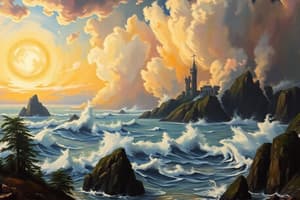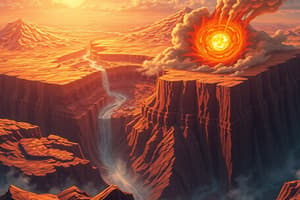Podcast
Questions and Answers
Which of the following factors does not significantly influence the impact of a natural hazard on a community?
Which of the following factors does not significantly influence the impact of a natural hazard on a community?
- Effectiveness of local building codes
- The color of residential buildings (correct)
- Population density in the affected area
- Availability of resources for disaster response
The Richter scale directly measures the intensity of ground shaking at a specific location during an earthquake.
The Richter scale directly measures the intensity of ground shaking at a specific location during an earthquake.
False (B)
What is the primary cause of earthquakes?
What is the primary cause of earthquakes?
sudden release of energy along fault lines
__________ are large waves often triggered by underwater earthquakes or volcanic eruptions.
__________ are large waves often triggered by underwater earthquakes or volcanic eruptions.
Match the hazard with its primary triggering event:
Match the hazard with its primary triggering event:
Which type of hazard is least directly associated with tectonic plate movement?
Which type of hazard is least directly associated with tectonic plate movement?
Implementing stricter building codes is primarily an adaptation strategy, rather than a mitigation strategy, for earthquake-prone regions.
Implementing stricter building codes is primarily an adaptation strategy, rather than a mitigation strategy, for earthquake-prone regions.
Explain the relationship between tectonic activity and tsunamis.
Explain the relationship between tectonic activity and tsunamis.
Flashcards
Natural Hazards
Natural Hazards
Events or phenomena occurring naturally that threaten life and property.
Categories of Natural Hazards
Categories of Natural Hazards
Natural hazards can be geological, hydrological, atmospheric, or biological.
Vulnerability Factors
Vulnerability Factors
Conditions influencing how much damage a natural hazard can cause, such as population density.
Tectonic Hazards
Tectonic Hazards
Signup and view all the flashcards
Earthquake Causes
Earthquake Causes
Signup and view all the flashcards
Tsunamis
Tsunamis
Signup and view all the flashcards
Mitigation Strategies
Mitigation Strategies
Signup and view all the flashcards
Connection of Hazards
Connection of Hazards
Signup and view all the flashcards
Study Notes
Natural Hazards
- Natural hazards are events or phenomena that occur naturally and pose a threat to human life and property.
- These hazards can be categorized based on their origin, such as geological, hydrological, atmospheric, or biological.
- Examples of natural hazards include earthquakes, floods, volcanic eruptions, wildfires, and droughts.
- The impact of a natural hazard often depends on the degree of vulnerability of the affected population and infrastructure.
- Vulnerability factors include population density, building codes, and the availability of resources for disaster response.
- The frequency and intensity of natural hazard events can be influenced by factors such as climate change.
Tectonic Hazards
- Tectonic hazards are hazards associated with the movement and interaction of Earth's tectonic plates.
- These hazards often result in significant damage and loss of life.
- Key tectonic hazards include earthquakes, volcanic eruptions, tsunamis, and landslides.
- Earthquakes are caused by the sudden release of energy along fault lines where tectonic plates meet.
- Seismic waves, generated by the earthquake, propagate through the Earth's crust and cause ground shaking.
- Earthquake magnitude is measured on scales such as the Richter scale, which quantify the amount of energy released.
- Volcanic eruptions involve the release of molten rock, ash, gases, and pyroclastic flows from a volcano.
- The type of eruption and the associated hazards depend on the volcano's characteristics and the nature of the magma.
- Tsunamis are large waves generated by sudden displacement of water in bodies of water, often triggered by earthquakes, volcanic eruptions, or landslides in the ocean.
- The height of tsunami waves can vary significantly depending on the factors leading to the disturbance.
- Landslides are rapid movements of rock, soil, or debris down a slope, typically triggered by earthquakes, heavy rainfall, or volcanic activity.
Connection Between Natural and Tectonic Hazards
- Many natural hazards are directly linked to tectonic processes.
- Earthquakes, volcanic eruptions, and tsunamis are examples of how tectonic activities can trigger significant natural hazards.
- Understanding plate tectonics is crucial for assessing the potential for these types of risks.
Mitigation Strategies
- Mitigation and adaptation strategies help reduce the impact of natural hazards, including tectonic hazards.
- Implementing effective building codes for earthquake resistance and developing early warning systems for tsunamis are examples of such measures.
- Hazard mapping, land-use planning, and public education are critical elements of disaster preparedness.
- Effective emergency response and recovery strategies are equally important in minimizing loss of life and property in the aftermath of natural hazards.
Studying That Suits You
Use AI to generate personalized quizzes and flashcards to suit your learning preferences.



